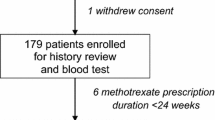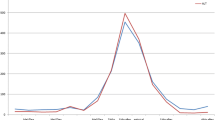Abstract
The objective of this study was to report our experience concerning the effectiveness of the prophylactic administration of lamivudine in hepatitis B virus surface antigen (HBs Ag) positive patients with rheumatologic disease. From June 2004 to October 2006, 11 HBs Ag positive patients with rheumatologic diseases, who were on both immunosuppressive and prophylactic lamivudine therapies, were retrospectively assessed. Liver function tests, hepatitis B virus (HBV) serologic markers, and HBV DNA levels of the patients during follow-up were obtained from hospital file records. Eleven patients (six male) with median age 47 years (range 27–73), median disease duration 50 months (range 9–178) and median follow-up period of patients 13.8 months (range 5–27) were enrolled in this study. Lamivudine therapy was started 3–7 days prior to immunosuppressive therapy in all patients. Baseline, liver function tests were elevated in two patients (fourth patient: ALT:122 IU/l, AST:111 IU/l, tenth patient:ALT:294 IU/l, AST:274 IU/l, with minimal changes in the liver biopsy in both). Shortly after treatment their tests normalized and during follow-up period none of the patients had abnormal liver function tests. In four patients HBV DNA levels were higher than normal at baseline. Two of these normalized and the others increased later. In three additional patients, HBV DNA levels were increased during follow-up. None of the patients had significant clinical sings of HBV activation. Lamivudine was well tolerated and was continued in all patients. Prophylactic administration of lamivudine in patients who required immunosuppressive therapy seems to be safe, well tolerated and effective in preventing HBV reactivation.
Similar content being viewed by others
References
Mehmet D, Meliksah E, Serif Y, Gunay S, Tuncer O, Zeynep S (2005) Prevalence of hepatitis B infection in the southeastern region of Turkey: comparison of risk factors for HBV infection in rural and urban areas. Jpn J Infect Dis 58(1):15–19
Yeo W, Chan PK, Zhong S, Ho WM, Steinberg JL, Tam JS, Hui P, Leung NW, Zee B, Johnson PJ (2000) Frequency of hepatitis B virus reactivation in cancer patients undergoing cytotoxic chemotherapy: a prospective study of 626 patients with identification of risk factors. J Med Virol 62(3):299–307
Calabrese LH, Zein NN, Vassilopoulos D (2006) Hepatitis B virus (HBV) reactivation with immunosuppressive therapy in rheumatic diseases: assessment and preventive strategies. Ann Rheum Dis 65(8):983–989
Vassiliadis T, Garipidou V, Tziomalos K, Perifanis V, Giouleme O, Vakalopoulou S (2005) Prevention of hepatitis B reactivation with lamivudine in hepatitis B virus carriers with hematologic malignancies treated with chemotherapy a prospective case series. Am J Hematol 80(3):197–203
Gupta S, Govindarajan S, Fong TL, Redeker AG (1990) Spontaneous reactivation in chronic hepatitis B: patterns and natural history. J Clin Gastroenterol 12(5):562–568
Tur-Kaspa R, Burk RD, Shaul Y, Shafritz DA (1986) Hepatitis B virus DNA contains a glucocorticoid-responsive element. Proc Natl Acad Sci USA 83(6):1627–1631
Cheng AL, Hsiung CA, Su IJ, Chen PJ, Chang MC, Tsao CJ, Kao WY, Uen WC, Hsu CH, Tien HF, Chao TY, Chen LT, Whang-Peng J (2003) Lymphoma Committee of Taiwan Cooperative Oncology Group Steroid-free chemotherapy decreases risk of hepatitis B virus (HBV) reactivation in HBV-carriers with lymphoma. Hepatology 37(6):1320–1328
Cheng AL (1996) Steroid-free chemotherapy decreases the risk of hepatitis flare-up in hepatitis B virus carriers with non-Hodgkin’s lymphoma. Blood 87(3):1202
Di Marco V, Marzano A, Lampertico P, Andreone P, Santantonio T, Almasio PL, Rizzetto M, Craxi A (2004) Italian Association for the Study of the Liver (AISF) Lamivudine Study Group, Italy. Clinical outcome of HBeAg-negative chronic hepatitis B in relation to virological response to lamivudine. Hepatology 40(4):883–891
Fabrizi F, Dulai G, Dixit V, Bunnapradist S, Martin P (2004) Lamivudine for the treatment of hepatitis B virus-related liver disease after renal transplantation: meta-analysis of clinical trials. Transplantation 77(6):859–864
Berger A, Preiser W, Kachel HG, Sturmer M, Doerr HW (2005) HBV reactivation after kidney transplantation. J Clin Virol 32(2):162–165
Tsai FC, Hsieh SC, Chen DS, Sheu JC, Chen DS (2006) Reactivation of hepatitis B virus in rheumatologic patients receiving immunosuppressive agents. Dig Dis Sci 51:1627–1632
Author information
Authors and Affiliations
Corresponding author
Rights and permissions
About this article
Cite this article
Kalyoncu, U., Yonem, O., Calguneri, M. et al. Prophylactic use of lamivudine with chronic immunosuppressive therapy for rheumatologic disorders. Rheumatol Int 29, 777–780 (2009). https://doi.org/10.1007/s00296-008-0790-6
Received:
Accepted:
Published:
Issue Date:
DOI: https://doi.org/10.1007/s00296-008-0790-6




